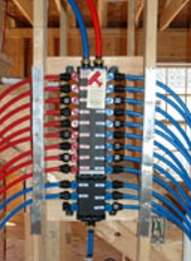Mark writes: I own a Cape-style house built in 1945 and worry about a leak developing in the iron water lines when I am not at home to shut off the water at the mains. Is there a reason not to use PEX or PVC rather than copper pipe? Is there any way to get an independent idea of what a plumber should charge to do this? I live in a small town and we seem to be largely at the mercy of the few plumbers in the area. I do not feel that I have enough plumbing experience to do the work myself.
Steve Bliss, of BuildingAdvisor.com responds: For water supply piping you can use copper, CPVC, or flexible PEX piping. PEX has become very popular in recent years because it is easier and quicker to install than copper. Both PEX and CPVC are widely used and approved for both hot and cold potable water, although some people report a slight plastic taste in drinking water, especially with a new installation. Research on PEX has shown that some brands and types of plastic piping have a greater effect on taste than others.
A standard point-of-use filter for drinking water should solve any taste problems, which will dissipate over time. There is no evidence of health problems related to plastic plumbing but, not surprisingly, there are debates on this issue. I have had PEX plumbing in a couple of homes and have not noticed any problems with taste or odor (although I do use a point-of-use filter at the kitchen sink for most drinking water).

There are several advantages to PEX, in addition to the cost. In remodeling, PEX is much easier to snake through the framing, requiring less cutting and patching of existing walls, floors, and ceilings. In new homes most plumbers use the “home run” system in which you use long, continuous runs to each fixture from a central manifold. Long runs eliminate most joints and connections in the walls and make it very easy to find leaks – at one end or the other on each run. Also, PEX can withstand freezing better than copper or CPVC, a definite plus in cold climates.
The long runs of a home-run system can significantly increase the total amount of water piping in a large home, compared with a traditional trunk-and-branch system. So some plumbers use the more traditional trunk-and-branch piping layout or a hybrid system. Also, the interior of PEX is smaller than equivalent-sized copper, so it is important to size the pipe correctly or risk lower volume at fixtures on long runs. Three-quarter-inch PEX is equivalent to ½-inch copper.
PEX is easier to master than copper for a DIY plumber like yourself, but a whole house is certainly a lot to take on. Connections are made with barbed fittings using a crimping tool or with special clamps.
If you are really worried about a pipe breaking, you could turn off the water at the main each day when you leave for work until the repair is made. A ball valve operated by a lever (rather than the older style globe valve with a round handle) makes turning the water on and off very easy.
If you just have one leaky pipe, you could certainly replace that one section of pipe for the time being and keep an eye on the rest of the system. In my experience, it’s very rare for an iron pipe to spontaneously burst unless it has been frozen or damaged. However, if the iron pipes are on their last legs, you need to be careful while working on them. I have seen leaks develop in iron pipes due to work being done that rattles or puts pressure on the piping.
As for pricing, plumbers are expensive everywhere. This is true for all licensed trades, such as plumbers and electricians, where there is great demand and limited supply. You can get a rough estimate of costs from cost books, but your best bet is to get two or three bids from local plumbers. For remodeling work, my favorite guides are the Craftman National Repair & Remodeling Estimator and the HomeTech Remodeling & Renovation Cost Estimator.
Leave a Reply